 |
|
|
| |
 |
|
|
| |
|
The Wheel -
1880 -
1885 -
1890 -
1895 -
1896 -
1897 -
1899 -
1900 -
1905 -
1910 |
![Three automobiles are parked at the corner of 18th (Eighteenth) and Stout streets in downtown Denver, Colorado. Men wearing suits sit in the cars; other men stand on the sidewalk in front of storefronts including: Colorado Winton Motor Carriage Company and the Bicycle Supply Company (1761 Stout) and the Schuster & Larimer Plumbing Company (1759 Stout). The awnings of the businesses are tied back. Street scene includes: a young boy on a bicycle, another holds a bicycle tire, and a man sits in the back of a parked truck. A woman peers from behind a curtain in a third-floor, arched window above the Winton Motor Car office. Date [1902?] Photograph by Joseph Collier.
Title: Cars in downtown Denver. Call Number: C-2.
URL - http://gowest.coalliance.org/cgi-bin/imager?00130002+C-2
Hyperlink to Denver Public Library.](../images/coautos.jpg) Photograph by Joseph Collier, 1902 - Western History/Genealogy Dept., Denver Public Library Traffic jam in front of the Colorado Winton Motor Carriage Company and the Bicycle Supply Company. | ||
|
Three new automobiles at the corner of 18th and Stout Streets in downtown Denver. Businesses
pictured include the Colorado Winton
Motor Carriage Company and the Bicycle Supply Company. Some of the world's best known automobile
brands began as bicycle companies, including Morris in England, Opel
in Germany and Peugeot in France.
The Dodge brothers built bicycles in Michigan. The Duryeas introduced the women's drop frame with their
Sylph bicycles in Massachussets and almost certainly built the automobile that struck a woman cyclist
in the first reported accident of its type in New York City on
May 30, 1896. In Dayton, Ohio,
inventors at the Wright Cycle Company built Van Cleve and
St. Clair bicycles to customer specifications while they dreamed of flight. Henry Ford used a bicycle
chain to connect a gasoline engine with the driving wheels on his
Quadricycle.
He hired the famous bicycle racer
Barney Oldfield as a racing team driver. | ||
|
1898
Portland's first automobile was a Locomobile which Henry Wemme had shipped west from Newton, Mass.
Contemporary accounts report this first car frightened so many horses that there were numerous
runaways. The German immigrant believed that operating his vehicle in Portland during that year
caused more runaways than there had been in the preceeding 20 years. In 1900 he sold the machine
to a Spokane, Wash. man. Wemme also owned Portland's second automobile, a Hayes-Apperson, which he
purchased in Kokomo, Ind. He bought Portland's first Oldsmobile, first Reo and first Pierce Arrow and
became president of the Portland Automobile Association. By 1905 there were 218 automobiles in Oregon,
40 of them in Portland. An Oldsmobile two-cylinder touring car sold for $1,550.00 and runabouts were
priced at $750.00. The Winton Model C, a four-cylinder model, was priced at $1,800.00 from Portland's
Ben Holladay Automobile Company at 495 Alder Street. The luxurious Pierce Arrow sold for $3,650.00. At the urging of the Portland Automobile Club, the Portland City Council raised the automobile speed limit from 8 to 10 miles per hour in fire limit areas and 15 m.p.h. elsewhere in the city on May 2, 1906. ![Sixteenth Street from Champa looking northwest to the May Company. This Denver street scene shows pedestrians, automobiles, streetcars, bicycles, and horse-drawn wagons. Date [between 1900 and 1909?] Formerly F1073.
URL - http://gowest.coalliance.org/cgi-bin/imager?10023357+X-23357
Hyperlink to Denver Public Library.](../images/codenstreet.jpg) Photographer unknown - Western History/Genealogy Dept., Denver Public Library Bicycles shared downtown Denver's 16th Street with trolleys, automobiles and horse-drawn wagons in the early 1900s. circa 1902 Crossing a street in downtown Denver or any city at the turn of the century could be an adventure. Horse-drawn wagons and trolleys competed with bicycles and the new automobiles. Pedestrians were reminded to watch their step -- downward -- as well as left and right before attempting any crossing. ![Laying sidewalk in Rifle, Garfield County, Colorado circa 1905. Men work with rakes, a wheelbarrow, tar, and a roller. Boys on horses or a bicycle look on. Date [between 1905 and 1915?] Call Number X-13183. Formerly F28425.
Hyperlink to Denver Public Library.](../images/cosidewalk.jpg) Photographer unknown - Western History/Genealogy Dept., Denver Public Library Bicycles 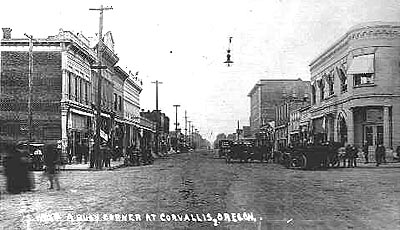 Photographer unknown - Salem Public Library Bicycles  Photographer unknown - Western History/Genealogy Dept., Denver Public Library Horses pulled the first streetcars, but they were soon replaced by electric motors.  Byron Collection, 1913 - The Museum of the City of New York 1913 Chicago to New York Auto Race. While information about this event is elusive, the back of the print includes some handwritten notes about the vehicle depicted. It is a 1913 Imp Cyclecar with two cylinders, 10 to 12 horsepower, and a maximum speed of 50 miles per hour. It sold new for $375. Cyclecars -- simple, economical vehicles that worked on the same principles as a bicycle -- were relatively new in 1913, and a New York-based cyclecar club was established in December of that year. Broken chains led to catastrophic accidents and hastened the acceptance of Fords and other automobiles.  Clyde Banks, 1928 - University of Washington Libraries Digital Collections 1928 |
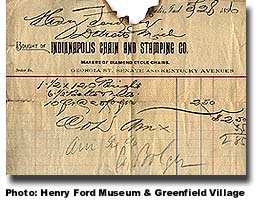 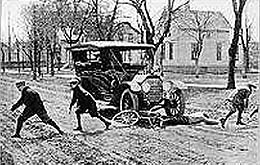 G.H. Atkin, Certificate No. 140, May 14, 1900. Reports at the corner of Jackson and State Strets, riding east, a young man on bicycle attempting to get out of way of pedestrian, got in front of my vehicle. I rang my bell repeatedly, but he did not seem to notice me. My vehicle struck his wheel and damaged same. I dismounted and ascertained he was not hurt. New York City's distinctions include the first bikeway, the first police bike patrols, and also the first car-bicycle collision on May 30, 1896. Charles Duryea is credited with introducing the drop-frame on his Sylph bicycles first produced in Chickopee, Mass. After building the first successful automobile in 1893, Charles and Frank Duryea became the first American automakers, producing 13 vehicles in Peoria, Illinois three years later. 1890, Rouse Duryea Cycle Co., of Peoria, is incorporated. Charles contracts in the Springfield, MA area to have his Sylph bicycle built. 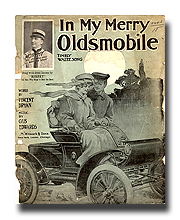 1895 Ransom Eli Olds, a manufacturer of stationary gasoline engines teams up with Frank Clark, the son of a carriage maker, to build a self-contained, gasoline-powered carriage. Your great grandfather's Oldsmobile was born when the Olds Motor Vehicle Company was founded 1897. It became a division of General Motors in 1908 and has 2,801 dealerships across the U.S. May 8, 1905 Oldsmobile sponsors the first trans-continental automobile race from New York City to Portland, Oregon, matching a pair of new Curved Dash models. Dwight Huss and Milford Wigle arrive 45 days later. December 12, 2000 General Motors announces it will discontinue the Oldsmobile line. Massive advertising and quality products could not shake the brand's stodgy image of "Your father's Oldsmobile," so America's first and oldest automaker will join the "boneshaker" and the "ordinary" in transportation museums. The last Oldsmobile to carry the brand will be the 2002 Bravada Sport Utility Vehicle.  National Automotive History Collection, Detroit Public Library 1902 Reality was as far from romanticism at the turn of the century as it is today. When roads dried out they became lines of rock-hard ruts that were as difficult for early cars like this Curved Dash Oldsmobile as they were for bicycles. 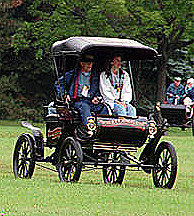 Photograph by Dale Atkins, AP July 4, 1904 Corvallis got its first car when Mark Rickard, the first person to own an automobile in Benton County, drove into town in a shining, 2-cylinder REO touring car that cost $1,450. It had a painted wooden body, varnished wood fenders, a wicker trunk and leather upholstery, but no top -- that and the windshield cost extra. The starting crank was positioned on the side of the car, so, in the event it started forward more quickly than intended, no one would be run over. According to Rickard, the car traveled about 20 miles an hour, and got 10 miles to the gallon. Car owners often purchased their gasoline at drug stores. Usually in pints or quarts, and never more than a gallon at a time. The REO was built by Ransom Eli Olds who resigned from his own Olds Motor Co. in 1904 after disagreements with financial backers. His REO Motor Car Company outsold Oldsmobile in 1905 and 1906 and continued building cars until 1936 and trucks until 1975. One of his most successful models was the stepvan used by police and deliverymen and immortalized in silent films, the REO Speedwagon.  Next: 1897 Also: Roads See 19th Century Bicycle News for a selected bibliography and historical resources online, or use the links to find other sites of interest. All rights reserved. | |